| Skip Navigation Links | |
| Exit Print View | |

|
Developing OTDs for Oracle Java CAPS Application Adapters Java CAPS Documentation |
| Skip Navigation Links | |
| Exit Print View | |

|
Developing OTDs for Oracle Java CAPS Application Adapters Java CAPS Documentation |
Developing OTDs for Application Adapters
Date and Time Stamp Requirements
Installing SAP JCo for SAP BAPI
To Install SAP JCo on Windows 32
SAP JCo and SAP IDoc Class Library Installation
To Download the SAP Java IDoc Class Library
To Create IDoc OTDs Directly From SAP
To Create IDOC OTDs From a Description File
Exporting the IDOC File from SAP
To Download the IDoc Description File From SAP
Saving the IDoc Description File (After 4.6)
To Save the IDoc Description File From SAP
Configuring Your System Before Creating the OTD
Configuring NetBeans to Work with Siebel
Installing seebeyond.sif for Siebel 7.5.x
Installing SiebelMessage XSD Generation Process.xml for Siebel 7.7 and 7.8.x
Encoding Behavior for Redefinitions
enableUnmarshalValidation(boolean enable) Method
marshal(String charset) Method
marshal(OtdOutputStream out) Method
marshal(OtdOutputStream out, String charset) Method
unmarshal(OtdInputStream in) Method
unmarshal(OtdInputStream in, String charset) Method
unmarshal(byte[] in, String charset) Method
unmarshalFromString(String in) Method
useEncoding(String enc) Method
Creating an Oracle Applications OTD
To Create an Oracle Applications OTD
Exposed Oracle Applications OTD Nodes
Generating DTDs from PeopleTools 8.13
Generating and Publishing an XML Test Message
To generate a PeopleSoft XML message
Extracting and Viewing the XML Test Message
Generating a DTD for the XML File
The SWIFT AG Adapter includes the SAGOutboundadapter Object Type Definition.
The SAGOutboundadapter OTD structure is organized into five sections: Configuration, Constants, Primitives, RemoteApis (Remote APIs), and Services.
Figure 19 SAGOutboundadapter OTD

The figure above shows the SAGOutbound Adapter OTD as displayed in the Collaboration Editor.
The Configuration node directly corresponds to the adapter Connectivity Map and Environment Configuration properties. The OTD Configuration node offers dynamic configuration (configuration on the fly). Dynamic configuration allows you to edit the configuration, based on your Collaboration’s Business Rule logic, from the Java Collaboration Editor, dynamically changing a parameter without shutting down your Project.
As displayed in the figure below, the Configuration section of the OTD is a Java representation of the SWIFT AG Adapter Configuration file. The Configuration section with the expanded FileActClient node and sub-nodes is displayed in the figure below.
Figure 20 SAGOutboundadapter OTD - Configuration Node
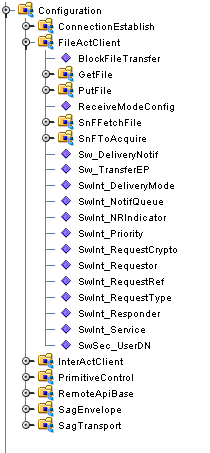
The Constants node provides a convenient way to select SNL related constants. Constants are literal values that have a name (see the figure below).
OTD Constants are presented in the Collaboration Editor so that you can simply drag and drop the Constant to a Business Rule, avoiding possible case or spelling errors.
Figure 21 SAGOutboundadapter OTD - Constants Node
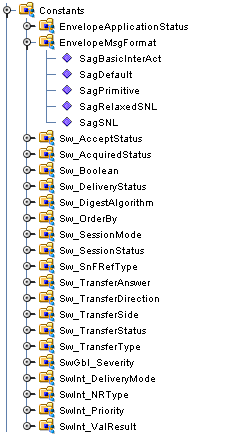
The Primitives node provides the full set of SNL Primitives as defined by the SNL specification. For information regarding any of the SNL Primitives, refer to the SWIFTAlliance Gateway Documentation. The SNL Primitives node and sub-nodes are displayed in the figure below.
Advanced users can construct their own Primitives and send the Primitive using the SWIFT AG Adapter API, directly communicating with SWIFTNet. Once they get a response to their request, they can parse the response based on their Primitives. The parser is provide in the OTDs Primitives section. The response can be dragged to the appropriate node to parse the response.
Figure 22 SAGOutboundadapter OTD - Primitives Node
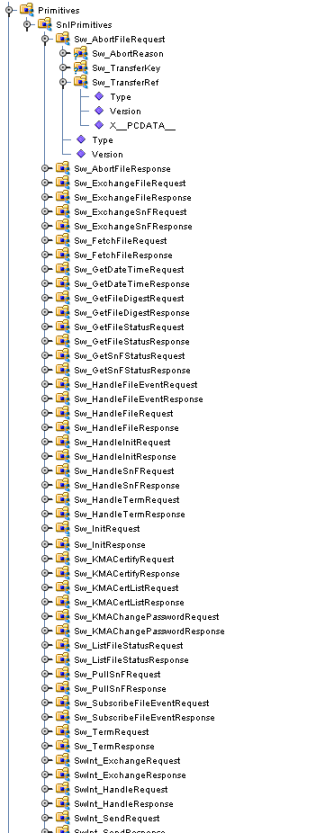
The SAGOutboundadapter OTD’s RemoteApis node exposes the SWIFT Remote API’s client APIs. Just as the Primitives section provide a “message structure”, the RemoteApis section provides a “communication function structure”. The Remote APIs allow you to perform special lower level communication functions.
Figure 23 SAGOutboundadapter OTD - Remote APIs Node
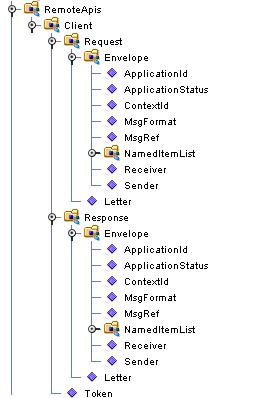
The Service section of the OTD allows you to perform higher level message and communication functions. Right-click the FileActClient or InterActClient node in the Collaboration to view the available methods to perform your business functions (exchange message, get file, put file, queue access, and so forth).
Figure 24 SAGOutboundadapter OTD - Services Node
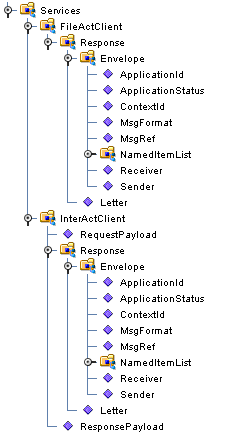
See the sample Projects for an example of how this OTD is used to create your business logic. The prjSAGCert Project demonstrates several business functions with one Collaboration.